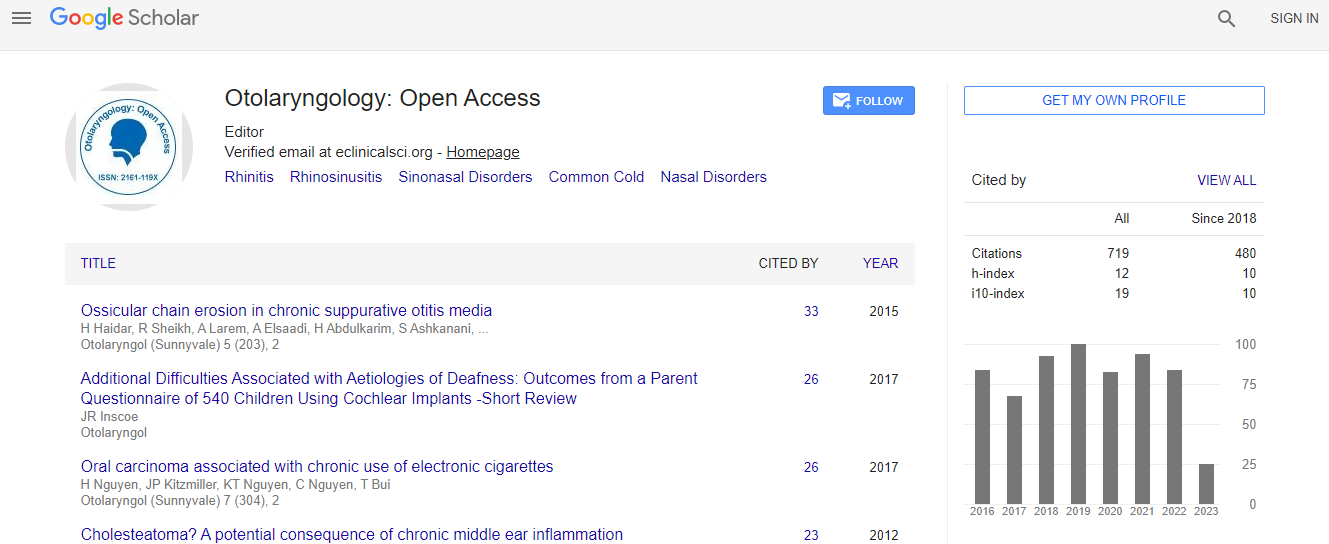Our Group organises 3000+ Global Conferenceseries Events every year across USA, Europe & Asia with support from 1000 more scientific Societies and Publishes 700+ Open Access Journals which contains over 50000 eminent personalities, reputed scientists as editorial board members.
Open Access Journals gaining more Readers and Citations
700 Journals and 15,000,000 Readers Each Journal is getting 25,000+ Readers
Google Scholar citation report
Citations : 925
Otolaryngology: Open Access received 925 citations as per Google Scholar report
Otolaryngology: Open Access peer review process verified at publons
Indexed In
- Index Copernicus
- Google Scholar
- Sherpa Romeo
- Open J Gate
- Genamics JournalSeek
- RefSeek
- Hamdard University
- EBSCO A-Z
- OCLC- WorldCat
- Publons
- Geneva Foundation for Medical Education and Research
- ICMJE
Useful Links
Recommended Journals
Related Subjects
Share This Page
Submandibular gland transfer: Prevention of post-treatment xerostomia in oropharyngeal cancer patients
5th Global Summit and Expo on Head, Neck and Plastic Surgery
Ryan H Sobel
Johns Hopkins Head & Neck Surgery-Greater Baltimore Medical Center, USA Milton J. Dance Jr. Head and Neck Center at GBMC, USA
Posters & Accepted Abstracts: Otolaryngol (Sunnyvale)
Abstract
Oropharyngeal cancers are on the rise globally. Of late, many innovations have been applied to optimally treat this complex cohort of patients. A multidisciplinary treatment approach is crucial in meeting the complex needs of patients with head and neck disease as well as optimizing oncologic and functional outcomes. In particular, the application of transoral robotic surgery (TORS), a minimally-invasive, robotic-assisted surgical procedure, to the treatment paradigm has revolutionized the surgical approach, reducing long-term dysfunction. It offers a faster return to day-to-day activities; significantly less morbidity, less complications, scarring and risk of infection and reduced risk of long-term swallowing problems. In these cases, adjuvant radiation is often indicated. For patients with tumors precluding an upfront surgical approach, primary chemoradiation is an effective treatment. One of the most troubling sequalae from radiation treatment is xerostomia. This is a largely irreversible change that leads to the development of new medical problems that significantly affect quality of like. Submandibular gland transfer is a novel approach for preservation of salivary function in the prevention of post-radiation xerostomia. It is a relatively minor surgical procedure that when performed prior to radiation treatment can significantly improve quality of life. This has significant implications on patients swallowing function and oral comfort level during and post-treatment. Advances in other types of treatment techniques are currently in development which may have a major impact on how cancer patients are treated in the future.Biography
Email: rsobel@gbmc.org

 Spanish
Spanish  Chinese
Chinese  Russian
Russian  German
German  French
French  Japanese
Japanese  Portuguese
Portuguese  Hindi
Hindi 
